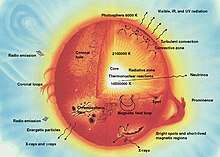HIP 56948
HIP 56948 (also known as HD 101364) is a solar twin star of type G5V.[2] It is one of the most sun-like stars yet known in terms of size, mass, temperature, and chemical makeup. Our sun is about 4.6 billion years old, and HIP 56948 is believed to be about 7.1 billion years old. Both stars are between a third and a halfway through their life on the main sequence.[6][7]
| Observation data Epoch Equinox | |
|---|---|
| Constellation | Draco |
| Right ascension | 11h 40m 28.48381s[1] |
| Declination | +69° 00′ 30.5995″[1] |
| Apparent magnitude (V) | 8.70 |
| Characteristics | |
| Spectral type | G5V[2] |
| U−B color index | 0.155 |
| B−V color index | 0.647 ± 0.014[1] |
| Variable type | none |
| Astrometry | |
| Radial velocity (Rv) | 5.4[3] km/s |
| Proper motion (μ) | RA: –126.96[1] mas/yr Dec.: –2.13[1] mas/yr |
| Parallax (π) | 15.68 ± 0.67[1] mas |
| Distance | 208 ± 9 ly (64 ± 3 pc) |
| Absolute magnitude (MV) | 4.81 |
| Details | |
| Mass | 1.02 ± 0.02[4] M☉ |
| Radius | 0.99 R☉ |
| Luminosity | 0.99[5] L☉ |
| Surface gravity (log g) | 4.409[5] cgs |
| Temperature | 5795[5] K |
| Metallicity [Fe/H] | 0.02[5] dex |
| Age | ~7.1[6] Gyr |
| Other designations | |
| Database references | |
| SIMBAD | data |
| Exoplanet Archive | data |
It is 208 light years away in the constellation of Draco,[8] lying about halfway between Polaris and Dubhe on the celestial sphere.[9] Astronomers have looked for planets in the system, so far without finding any. These observations suggest that the star does not have any hot Jupiters.[10]
Discovery
Jorge Meléndez of the Australian National University and Iván Ramírez of the University of Texas analysed the star in 2007 using the 2.7 metre Harlan J. Smith telescope at McDonald Observatory.[11]
Lithium abundance
Most other solar analogs such as 18 Scorpii are unlike the sun in that they have several times the lithium abundance. HIP 56948 is among the best candidates for a solar twin because of the known possible contenders, its lithium abundance most resembles that of our own star.[5][12] A 2009 high-dispersion spectroscopic study from the Astronomical Society of Japan confirms this.[5]
Significance

In the abstract to their paper, the star's discoverers say:[7]
For more than a decade, 18 Sco (HD 146233) has been considered the star that most closely resembles the Sun, even though significant differences such as its Li content, which is about 3 times solar, exist. Using high-resolution, high-S/N spectra obtained at McDonald Observatory, we show that the stars HIP 56948 and HIP 73815 are very similar to the Sun in both stellar parameters and chemical composition, including a low Li abundance, which was previously thought to be peculiar in the Sun. HIP 56948, in particular, has stellar parameters identical to solar within the observational uncertainties, being thus the best solar twin known to date. HIP 56948 is also similar to the Sun in its lack of hot Jupiters. Considering the age of this star (~1 ± 1 Gyr older than the Sun)[Notes 1] and its location and orbit around the Galaxy, if terrestrial planets exist around it, they may have had enough time to develop complex life, making it a prime target for SETI.
— Jorge Meléndez and Iván Ramírez, 8 October 2007
References
- Footnotes
- The star's age estimate has been revised several times in different studies, most recently (as of February 2020) to 7.1 Gyr.[6]
- Citations
- van Leeuwen, F. (November 2007). "Validation of the new Hipparcos reduction". Astronomy and Astrophysics. 474 (2): 653–664. arXiv:0708.1752. Bibcode:2007A&A...474..653V. doi:10.1051/0004-6361:20078357.Vizier catalog entry
- Vázquez, M.; Pallé, E.; Rodríguez, P. Montañés (2010). "Is Our Environment Special?". The Earth as a Distant Planet: A Rosetta Stone for the Search of Earth-Like Worlds. Astronomy and Astrophysics Library. Springer New York. pp. 391–418. doi:10.1007/978-1-4419-1684-6. ISBN 978-1-4419-1683-9. See table 9.1.
- Nordström, B.; et al. (May 2004). "The Geneva-Copenhagen survey of the Solar neighbourhood. Ages, metallicities, and kinematic properties of ˜14 000 F and G dwarfs". Astronomy and Astrophysics. 418 (3): 989–1019. arXiv:astro-ph/0405198. Bibcode:2004A&A...418..989N. doi:10.1051/0004-6361:20035959.
- Do Nascimento, J. D., Jr.; Castro, M.; Meléndez, J.; Bazot, M.; Théado, S.; Porto de Mello, G. F.; de Medeiros, J. R. (July 2009). "Age and mass of solar twins constrained by lithium abundance". Astronomy and Astrophysics. 501 (2): 687–694. arXiv:0904.3580. Bibcode:2009A&A...501..687D. doi:10.1051/0004-6361/200911935.CS1 maint: multiple names: authors list (link)
- Takeda, Yoichi; Tajitsu, Akito (June 2009). "High-Dispersion Spectroscopic Study of Solar Twins: HIP 56948, HIP 79672, and HIP 100963". Publications of the Astronomical Society of Japan. 61 (3): 471–480. arXiv:0901.2509. Bibcode:2009PASJ...61..471T. doi:10.1093/pasj/61.3.471.
- M. Mittag; K.-P. Schröder; A. Hempelmann; J.N. González-Pérez; and J.H.M.M. Schmitt (3 September 2018). "Chromospheric activity and evolutionary age of the Sun and foursolar twins". Astronomy & Astrophysics. 591: A89. arXiv:1607.01279v1. doi:10.1051/0004-6361/201527542.CS1 maint: multiple names: authors list (link)
- Meléndez, Jorge; Iván Ramírez (2007). "HIP 56948: A Solar Twin with a Low Lithium Abundance (abstract)". Astrophysical Journal Letters. 669 (2): L89. arXiv:0709.4290. Bibcode:2007ApJ...669L..89M. doi:10.1086/523942.
- Shiga, David (2007-10-03). "Sun's 'twin' an ideal hunting ground for alien life". New Scientist. Retrieved 2009-05-28.
- The Telegraph, retrieved 5 November 2010.
- New Scientist, retrieved 5 October 2009.
- "Light of the Dragon: Astronomers Discover Sun's Twin at McDonald Observatory". Astrobiology Magazine. 2007-11-13. Retrieved 2009-05-28.
- Mosher, Dave (2007-11-09). "Astronomers find the sun's long-lost twin: Happy reunion unlikely, as the star is about 200 light-years away". NBC News. Retrieved 2009-05-28.